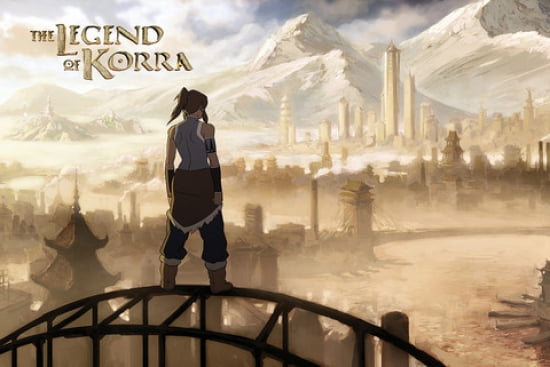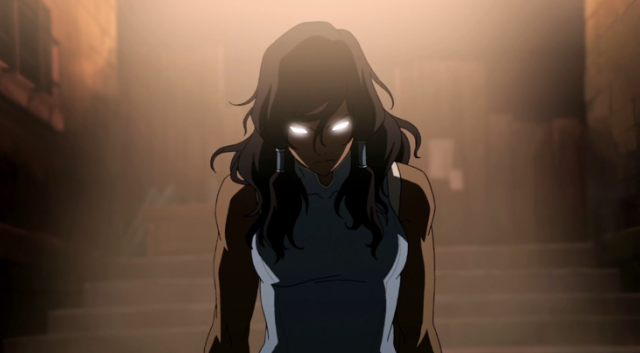Media - Animation - The Legend of Korra: Book 4

The Legend of Korra is a particularly interesting piece of media when it comes to its depiction of PTSD. The main character, Korra, starts the series as a 17 year old girl in charge of bringing balance to the world of benders. Benders, or those who are able to bend one of the four elements, Fire, Earth, Water and Air, have formed 4 distinct nations: the Imperial Fire Nation, the Water Tribe, the wandering Air Nomads, and the massive State of the Earth Kingdom. Korra is the Avatar, a being reencarnated through time and charged with keeping the four nations in balance so that none has supremacy over the others.
Among the Avatar's duties, they must try to reconcile the human world with the spirit world, heralded by timeless beings that can disrupt or help the flow of the earth. To help in this endeavor, the Avatar is the only person granted with the ability to bend all four elements. Additionally, when in life threatening situations, the Avatar is able to enter the Avatar State, wielding massive amounts of bending power in unheard of methods in order to protect others and stay alive.
It is this avatar state, which I believe is actually representative of a hyper-aroused trauma response, that interests me most from this series.
During my viewing of the show, I chose to start at the moment of trauma, at the end of season 3. In it, a group of anarchists is bent on getting rid of the concept of an Avatar altogether. During their quest, Korra is taken hostage and more than just her own life lies at stake. Having already been stripped of access to her past lives, The anarchists, known as the red lotus, plan to kill Korra while she is in the Avatar State. Doing so would end the cycle of rebirth for the avatar entirely, leaving the world without an Avatar.
During this event, Korra is chained, both hands and feet, and suspended in the air. She is then covered in mercury which absorbs into her skin at massive quantities. This poisonous contact induces the avatar state, which Korra fights against. Her goal becomes to die without being under the avatar state, thereby preserving her reincarnation. However, her will to do so is not strong enough, and she allows the avatar state to manifest and take out the red lotus. Just before the climax of this fight, Korra, who is increasingly falling to the deathly strokes of the mercury, has her breathe sucked out entirely by the leader of the anarchists, and briefly dies before being resuscitated and having some of the mercury extracted from her body.
What follows the end of this season is a season marked by Korra's post traumatic stress. Korra, broken and unfeeling, leaves republic city a hero, but feeling weak. Her time is spent with a well known healer in the south pole, who finds that she is paralyzed not from any physical ailment, but from the trauma she experienced and her own self loathing at not being strong enough to live up to the duty of the Avatar.
The way the season approaches trauma is interesting. It begins by having Korra undergo bottom up therapy, as she is given grounding techniques that allow her to slowly regain control of her limbs and eventually lead her to walk. However movement is only the first step. After a 3 year time period, Korra, able to walk again, heads out to go back to her city home. However, as she makes the journey alone, she suffers from flashbacks of her trauma - still images from various times she has been in life threatening situations. Immediately after a flashback, she will then see a manifestation of her trauma response: an image of herself, in the avatar state (which as I have said before I believe to be representative of a trauma response), bound in chains. When this vision appears, she has a physical response and feels the need to fight it physically. This leads to several incidents where she releases massive bending attacks at nothing while others, confused and scared, watch on.

The next time we see Korra work on her trauma, it is in a much more physical approach. An ancient master metal bender finds Korra in a forest. There, Korra undergoes safe reenactments of fights. These fights give her back some of her old self, and after a time, she asks the master metal bender, Toph, to take out the remaining fragements of mercury in her body so that she can finally heal. However, this does not go as planned. Korra seizes up immediately as she is flooded with flashbacks of her trauma. It takes more time, and discussion of what her trauma is, before Korra is able to try to remove and incorporate her own trauma. Her hands move back and forth, in motions similar to Tai Chi, as she bends the rest of the mercury out of her body.
From here, Korra seems to be cured, and at least able to function on a much higher basis. But the show does not pretend she is cured right away. As she begins to wrestle with her duties to the world as the Avatar once again, she is, in much higher stress situations, suffering from flashbacks and the spector of herself in the avatar state. She now has to acknowledge that her ailment is not wholly physical, but mental. She avoids going into the avatar state, even when needed to fight off a power hungry dictator.
Korra then realizes that she will not be able to move past her trauma until she confronts it.
The show chooses to do this very literally. She goes to visit the source of her trauma, the man, the anarchist that originally poisoned her with mercury. This experience acts as a metaphor where Korra must literally confront this trauma in order to incorporate the memories into her narrative. During her visit, the man guides her into meditation. He is chained up and as he guides her into the spirit world and into confrontation of her fear, she is able to adjust her memories. The spirit world here acts like a dream state where she can safely look on her trauma and integrate it into her narrative. When she leaves this meeting, she, like many who are treated with EMDR, says that she feels whole now that she has accepted her trauma.
In the last three episodes following this, Korra never experiences another flashback, though it is clear that she is now able to show much greater empathy to her enemies experiencing their own traumatic issues.
Overall, I think what they have done very well in this show is demonstrate that the process of reintegrating trauma takes multiple and varied steps. They show Korra get better, falter, be retraumatized and eventually find a way to move forward and live with what has happened to her. While they never directly call what Korra experiences PTSD, it is clear that the show-runners have made PTSD a massive part of her narrative, and have given time and thought into how they represent her treatments without trying to claim any perfect way to heal trauma. The approach is nuanced, intense and personal. And most importantly, it is humanizing. The viewer is able to empathize with Korra, even as she relives trauma and lashes out, and they do not make her seem like any less of a hero in spite of the issues she must overcome inside herself.

Comments
Post a Comment